Flash Characteristics and Precipitation Metrics of Western U.S. Lightning-Initiated Wildfires from 2017
Abstract
1. Introduction
- Characterize the flash density, polarity, 2-min rainfall rate, and 24-h precipitation total at the location of the fire-starting flash and all other flashes surrounding the fire.
- Characterize the distance between the fire-starting lightning flash and the local maximum in precipitation, the precipitation rate at the time of the lightning flash, and the highest flash density within a 400 km2 area around the fire start location.
- Determine the frequency at which various thresholds used to define dry lightning are exceeded in the Western United States where LIW is most frequent.
2. Materials and Methods
2.1. Data
2.1.1. Fire Database and Case Selection
2.1.2. Lightning Data
2.1.3. Precipitation Data
2.2. Data Interrogation and Statistical Analysis
3. Results and Discussion
3.1. Flash Characteristics
3.2. Rainfall Metrics of Fire Starters and Non-Fire Starters
3.3. Analysis and Quantification of Fire Initiation with Respect to Local Distances
3.4. Case Studies
3.4.1. Parker 2 Fire
3.4.2. Lizard Fire
3.4.3. Bridge Creek Fire
3.5. Comparisons with Previous LIW Analyses
4. Conclusions
Author Contributions
Funding
Acknowledgments
Conflicts of Interest
Appendix A
| FS Flashes | NFS Flashes | |
|---|---|---|
| 2-min rain rate (mm h−1) | ||
| 25th percentile | 0.43 | 1.65 |
| Median | 1.69 | 4.65 |
| 75th percentile | 4.66 | 15.55 |
| Mean | 4.33 | 12.36 |
| Standard deviation | 7.41 | 17.73 |
| Z-Score | −5.58 | |
| WMW test p-value | 1.21 × 10−8 | |
| FS Flashes | NFS Flashes | |
|---|---|---|
| 24-h QPE storm total (mm) | ||
| 25th percentile | 1.68 | 4.13 |
| Median | 2.94 | 8.55 |
| 75th percentile | 6.89 | 15.46 |
| Mean | 5.34 | 10.63 |
| Standard deviation () | 6.09 | 8.30 |
| Z-Score | −7.18 | |
| WMW test p-value | 3.58 × 10−13 | |
References
- Balch, J.K.; Bradley, B.A.; Abatzoglou, J.T.; Nagy, R.C.; Fusco, E.J.; Mahood, A.L. Human-started wildfires expand the fire niche across the United States. Proc. Natl. Acad. Sci. USA 2017, 114, 1946–2951. [Google Scholar] [CrossRef]
- National Interagency Fire Center. Available online: https://www.nifc.gov/ (accessed on 19 November 2019).
- Fuquay, D.M.; Baughman, R.G.; Taylor, A.R.; Hawe, R.G. Characteristics of seven lightning discharges that caused forest fires. J. Geophys. Res. 1967, 72, 6371–6373. [Google Scholar] [CrossRef]
- Fuquay, D.M.; Taylor, A.R.; Hawe, R.G.; Schmid, C.W., Jr. Lightning discharges that causes forest fires. J. Geophys. Res. 1972, 77, 2156–2158. [Google Scholar] [CrossRef]
- Kitagawa, N.; Brook, M.; Workman, E.J. Continuing currents in cloud-to-ground lightning discharges. J. Geophys. Res. 1962, 67, 637–647. [Google Scholar] [CrossRef]
- Latham, D.J.; Schleiter, J.A. Ignition Probabilities of Wildland Fuels Based on Simulated Lightning Discharges; Res. Pap., INT-411; U.S Department of Agriculture, Forest Service, Intermountain Research Station: Ogden, UT, USA, 1989; p. 16.
- Anderson, K. A model to predict lightning-caused fire occurrences. Int. J. Wildland Fire 2002, 11, 163–172. [Google Scholar] [CrossRef]
- Saba, M.M.F.; Pinto, O.; Ballarotti, M.G. Relation between lightning return stroke peak current and following continuing current. Geophys. Res. Lett. 2006, 33. [Google Scholar] [CrossRef]
- Bitzer, P.M. Global distribution and properties of continuing current in lightning. J. Geophys. Res. Atmos. 2017, 122, 1033–1041. [Google Scholar] [CrossRef]
- Fuquay, D.M. Positive cloud-to-ground lightning in summer thunderstorms. J. Geophys. Res. 1982, 87, 7131–7140. [Google Scholar] [CrossRef]
- Rust, W.D.; MacGorman, D.R.; Taylor, W.L. Photographic verification of continuing current in positive cloud-to-ground flashes. J. Geophys. Res. 1985, 90, 6144–6146. [Google Scholar] [CrossRef]
- Schultz, C.J.; Nauslar, N.J.; Wachter, J.B.; Hain, C.R.; Bell, J.R. Spatial, temporal, and electrical characteristics of lightning in reported lightning-initiated wildfire events. Fire 2019, 2, 18. [Google Scholar] [CrossRef]
- Hall, B. Fire ignitions related to radar reflectivity patterns in Arizona and New Mexico. Int. J. Wildland Fire 2008, 16, 242–254. [Google Scholar] [CrossRef]
- Sopko, P.; Bradshaw, L.; Jolly, M. Spatial products available for identifying areas of likely wildfire ignitions using lightning location data-Wildand Fire Assessment System (WFAS). In Proceedings of the 6th International Lightning Meteorology Conference, San Diego, CA, USA, 18–21 April 2016; Available online: https://www.wfas.net/index.php/dry-lightning-experimental-products-97/ (accessed on 10 February 2019).
- Vant-Hull, B.; Thompson, T.; Koshak, W. Optimizing precipitation thresholds for best correlation between dry lightning and wildfires. J. Geophys. Res. Atmos. 2018, 123, 2628–2639. [Google Scholar] [CrossRef]
- Rorig, M.L.; Ferguson, S.A. Characteristics of lightning and wildland fire ignition in the Pacific Northwest. J. Appl. Meteorol. 1999, 38, 1565–1575. [Google Scholar] [CrossRef]
- Hardy, C.C.; Menakis, J.P.; Schmidt, K.M.; Long, D.G.; Simmerman, D.G.; Johnston, C.M. Coarse-Scale Spatial Data for Wildland Fire and Fuel Management; Rocky Mountain Research Station: Fort Collins, CO, USA, 1999. Available online: http://www.fs.fed.us/fire/fuelman/ (accessed on 10 February 2019).
- Williams, E.R.; Weber, M.E.; Orville, R.E. The relationship between lightning type and convective state of thunderclouds. J. Geophys. Res. 1989, 94, 13213–13220. [Google Scholar] [CrossRef]
- Carey, L.D.; Rutledge, S.A. A multiparameter radar case study of the microphysical and kinematic evolution of a lightning producing storm. Meteorol. Atmos. Phys. 1996, 59, 33–64. [Google Scholar] [CrossRef]
- Soula, S.; Chauzy, S. Some aspects of the correlation between lightning and rain activities in thunderstorms. Atmos. Res. 2001, 56, 355–373. [Google Scholar] [CrossRef]
- Price, C.; Federmesser, B. Lightning-rainfall relationships in Mediterranean winter thunderstorms. Geophys. Res. Lett. 2006, 33, L07813. [Google Scholar] [CrossRef]
- Pineda, N.; Montanya, J.; van der Velde, O.A. Characteristics of lightning related to wildfire ignitions in Catalonia. Atmos. Res. 2014, 135, 380–387. [Google Scholar] [CrossRef]
- Xu, W.; Adler, R.F.; Wang, N. Improving geostationary satellite rainfall estimates using lightning observations: Underlying lightning-rainfall-cloud relationships. J. Appl. Meteorol. Climatol. 2013, 52, 213–229. [Google Scholar] [CrossRef]
- Galanaki, E.; Lagouvardos, K.; Kotroni, V.; Flaounas, E.; Argiriou, A. Thunderstorm climatology in the Mediterranean using cloud-to-ground lightning observations. Atmos. Res. 2018, 207, 136–144. [Google Scholar] [CrossRef]
- Schultz, C.J.; Carey, L.D.; Schultz, E.V.; Blakeslee, R.J. Kinematic and microphysical significance of lightning jumps versus non-jump increases in total flash rate. Weather Forecast. 2017, 32, 275–288. [Google Scholar] [CrossRef] [PubMed]
- Pineda, N.; Rigo, T. The rainfall factor in lightning-ignited wildfires in Catalonia. Agric. For. Meteorol. 2017, 239, 249–263. [Google Scholar] [CrossRef]
- Abatzouglou, J.T.; Kolden, C.A.; Balch, J.K.; Bradley, B.A. Controls on interannual variability in lightning-caused fire activity in the western US. Environ. Res. Lett. 2016, 11, 045005. [Google Scholar] [CrossRef]
- Lindley, T.T.; Anderson, A.R.; Mahale, V.N.; Curl, T.S.; Line, W.E.; Lindstrom, S.S.; Bachmeier, A.S. Wildfire detection notifications for impact-based decision support services in Oklahoma using geostationary super rapid scan satellite imagery. J. Oper. Meteorol. 2016, 4, 182–191. [Google Scholar] [CrossRef]
- Murdoch, G.P.; Gitro, C.M.; Lindley, T.T.; Mahale, V.N. Identifying plume mode via WSR-88D observations of wildland fire convective plumes and proposed tactical decision support applications. J. Oper. Meteorol. 2019, 7, 153–163. [Google Scholar] [CrossRef]
- Lindley, T.T.; Speheger, D.A.; Day, M.A.; Murdoch, G.P.; Smith, B.R.; Nauslar, N.J.; Daily, D.C. Megafires on the Southern Great Plains. J. Oper. Meteorol. 2019, 7, 164–179. [Google Scholar] [CrossRef]
- Incident Web, InciWeb. Available online: https://inciweb.nwcg.gov (accessed on 20 October 2018).
- Fire Information for Resource Management System, FIRMS. Available online: https://firms.modaps.eosdis.nasa.gov/ (accessed on 20 October 2018).
- Schroeder, W.; Oliva, P.; Giglio, L.; Csiszar, I.A. The New VIIRS 375 m active fire detection data product: Algorithm description and initial assessment. Remote Sens. Environ. 2014, 143, 85–96. [Google Scholar] [CrossRef]
- Cummins, K.L.; Murphy, M.J. An overview of lightning location systems: History, techniques and data uses with an in-depth look at the U.S. NLDN. IEEE Trans. Electromagn. Compat. 2009, 51, 499–518. [Google Scholar] [CrossRef]
- Buck, T.; Nag, A.; Murphy, M.J. Improved Cloud-to-Ground and Intracloud Lightning Detection With the LS7002 Advanced Total Lightning Sensor. In Proceedings of the WMO Technical Conference on Meteorological and Environmental Instruments and Methods of Observation, Saint Petersburg, Russian, 7–9 July 2014; Available online: https://www.wmo.int/pages/prog/www/IMOP/publications/IOM-116TECO-2014/Session%201/P1_9_Buck_TotalLightningSensor.pdf (accessed on 1 February 2019).
- Nag, A.; Murphy, M.J.; Schulz, W.; Cummins, K.L. Lightning locating systems: Insights on characteristics and validation techniques. Earth Space Sci. 2015, 2, 65–93. [Google Scholar] [CrossRef]
- Smith, T.M.; Lakshmanan, V.; Stumpf, G.J.; Ortega, K.L.; Hondl, K.; Cooper, K.; Calhoun, K.M.; Kingfield, D.M.; Manross, K.L.; Toomey, R.; et al. Multi-Radar Multi-Sensor (MRMS) severe weather and aviation products. Bull. Am. Meteorol. Soc. 2016, 97, 1617–1630. [Google Scholar] [CrossRef]
- Zhang, J.; Howard, K.; Langston, C.; Kaney, B.; Qi, Y.; Tang, L.; Grams, H.; Wang, Y.; Cocks, S.; Martinaitis, S.; et al. Multi-Radar Multi-Sensor (MRMS) quantitative precipitation estimation: Initial operating capabilities. Bull. Am. Meteorol. Soc. 2016, 97, 621–638. [Google Scholar] [CrossRef]
- Nauslar, N.J. Examining the Lightning Polarity of Lightning Caused Wildfires. In Proceedings of the 23rd International Lightning Detection Conference, Tucson, AZ, USA, 18–19 March 2014. [Google Scholar]
- Wilks, D.S. Statistical Methods in the Atmospheric Sciences, 2nd ed.; Academic Press: Cambridge, MA, USA, 2005; pp. 131–177. ISBN 978-01-2751-966-1. [Google Scholar]
- Interactive Data Language, IDL. Available online: www.harrisgeospatial.com/ (accessed on 19 November 2019).
- Biagi, C.J.; Cummins, K.L.; Kehoe, K.E.; Krider, E.P. National Lightning Detection (NLDN) performance in southern Arizona, Texas and Oklahoma in 2003–2004. J. Geophys. Res. 2007, 112, D05208. [Google Scholar] [CrossRef]
- Medici, G.; Cummins, K.L.; Cecil, D.J.; Koshak, W.J.; Rudlosky, S.D. The intracloud lightning fraction in the Contiguous United States. Mon. Weather Rev. 2017, 145, 4481–4499. [Google Scholar] [CrossRef]
- Nieto, H.; Aguado, I.; Garcia, M.; Chuvieco, E. Lightning-caused fires in Central Spain: Development of a probability model of occurrence for two Spanish regions. Agric. For. Meteorol. 2012, 162, 35–43. [Google Scholar] [CrossRef]
- Helmus, J.J.; Collis, S.M. The Python ARM Radar Toolkit (Py-ART), a library for working with weather radar data in the Python programming language. J. Open Res. Softw. 2016, 4, e25. [Google Scholar] [CrossRef]
- Boccippio, D.J.; Cummins, K.L.; Christian, H.J.; Goodman, S.J. Combined satellite and surface-based estimation of the intracloud-cloud-to-ground lightning ratio over the Continental United States. Mon. Wea. Rev. 2001, 129, 108–122. [Google Scholar] [CrossRef]
- Rudlosky, S.D.; Goodman, S.J.; Virts, K.S.; Bruning, E.C. Initial Geostationary Lightning Mapper observations. Geophys. Res. Lett. 2019, 46, 1097–1104. [Google Scholar] [CrossRef]
- Goodman, S.J.; Blakeslee, R.J.; Koshak, W.J.; Mach, D.M.; Bailey, J.; Buechler, D.; Carey, L.; Schultz, C.J.; Bateman, M.G.; McCaul, E., Jr.; et al. The GEOS-R Geostationary Lightning Mapper (GLM). Atmos. Res. 2013, 125, 34–49. [Google Scholar] [CrossRef]
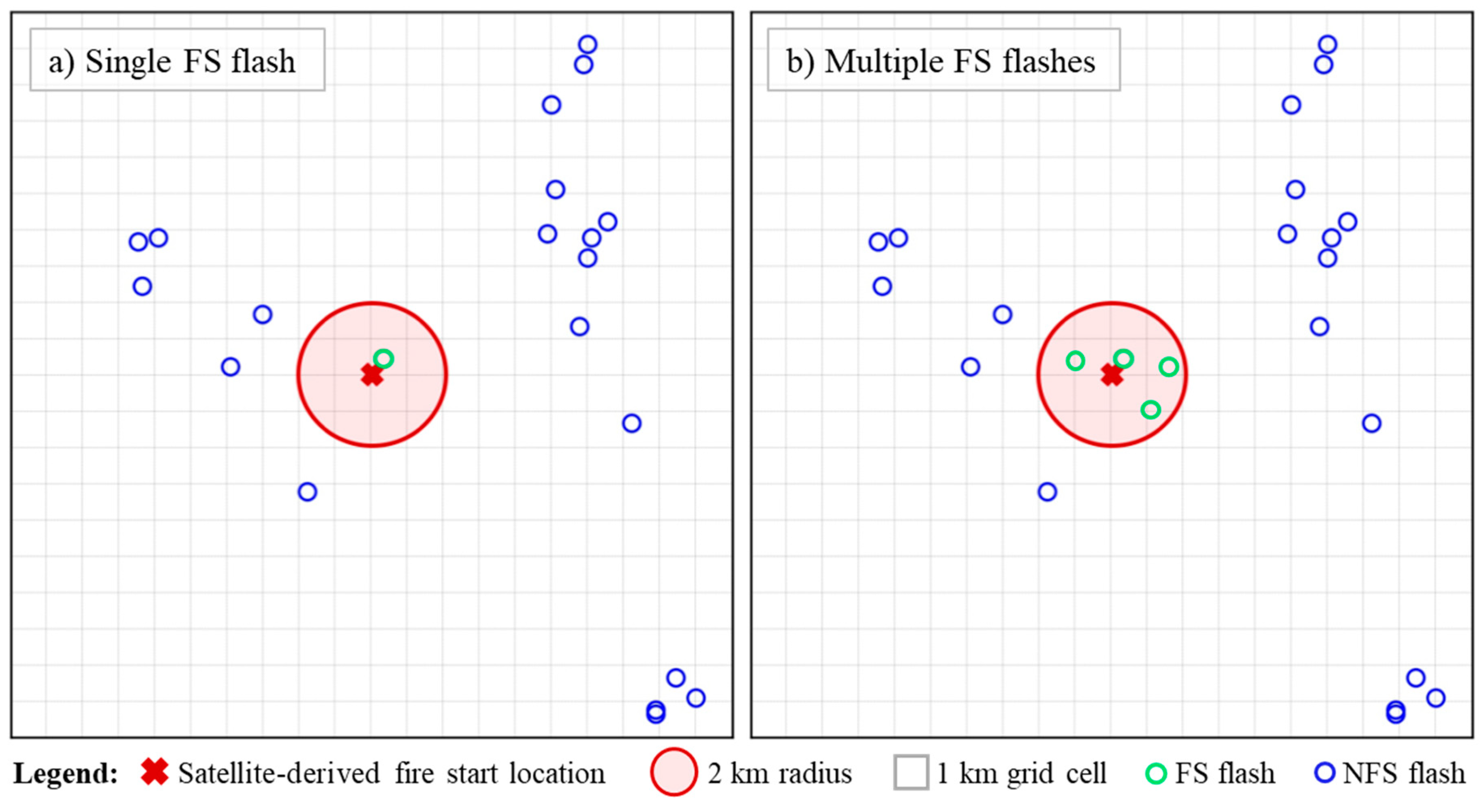
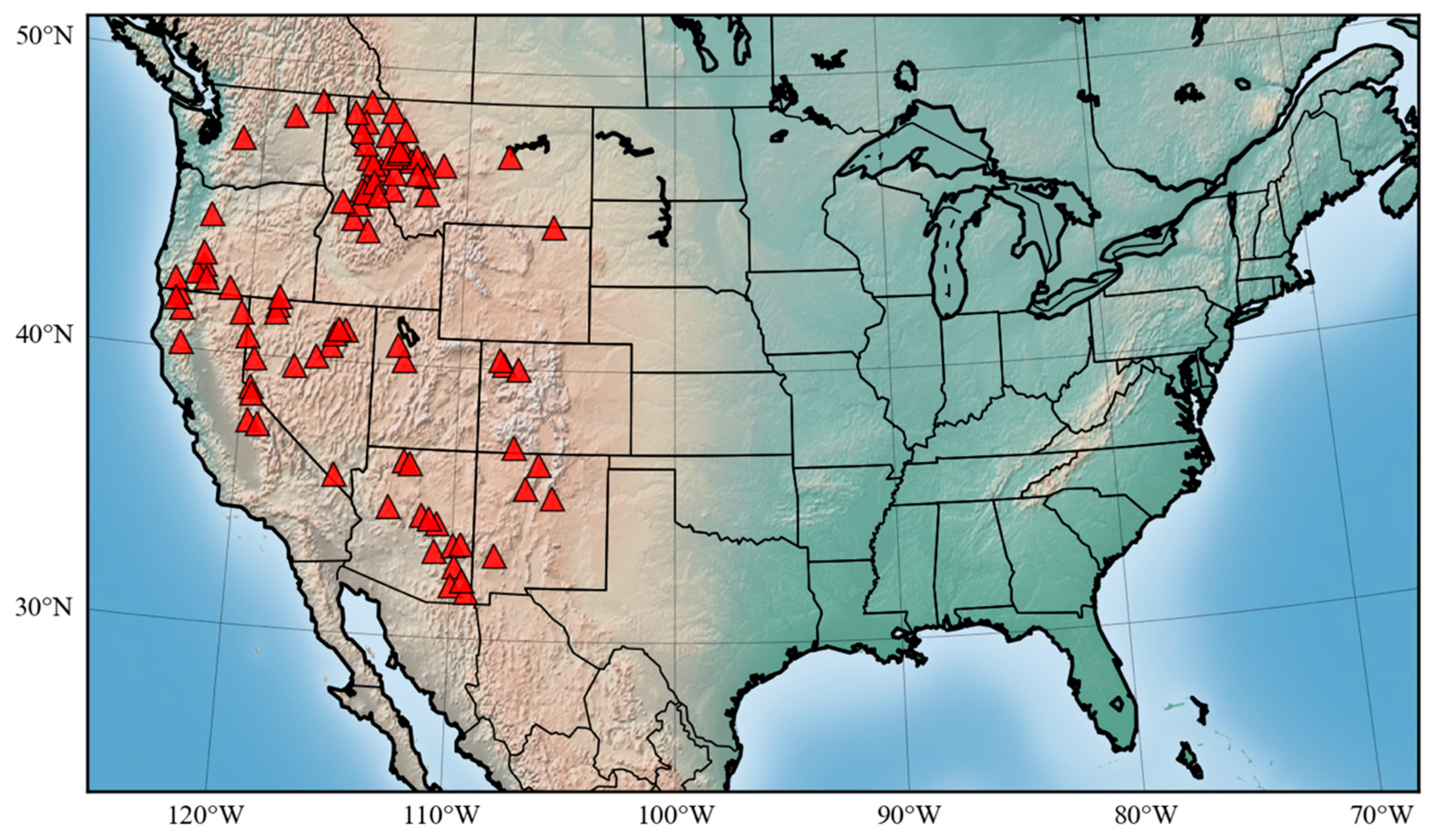
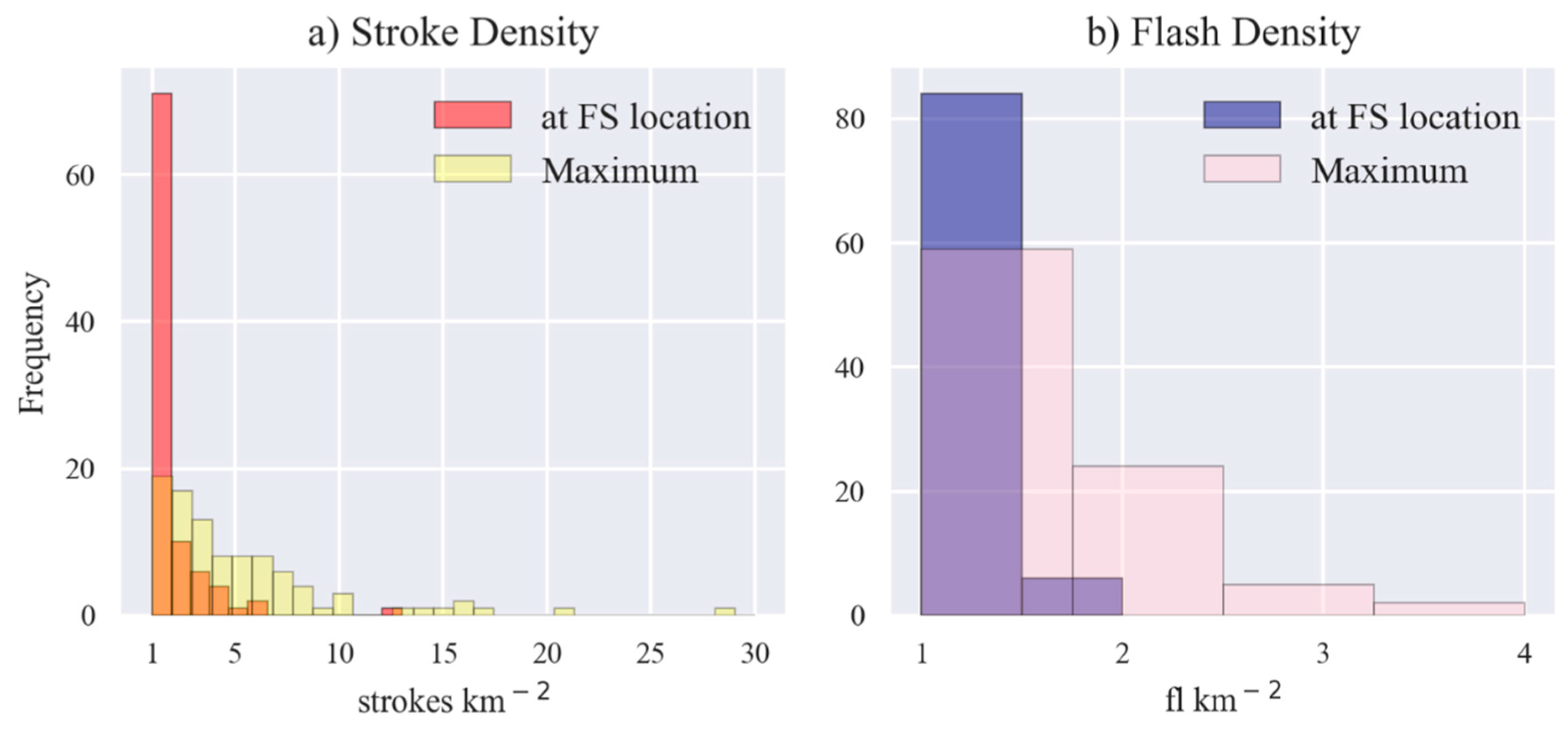

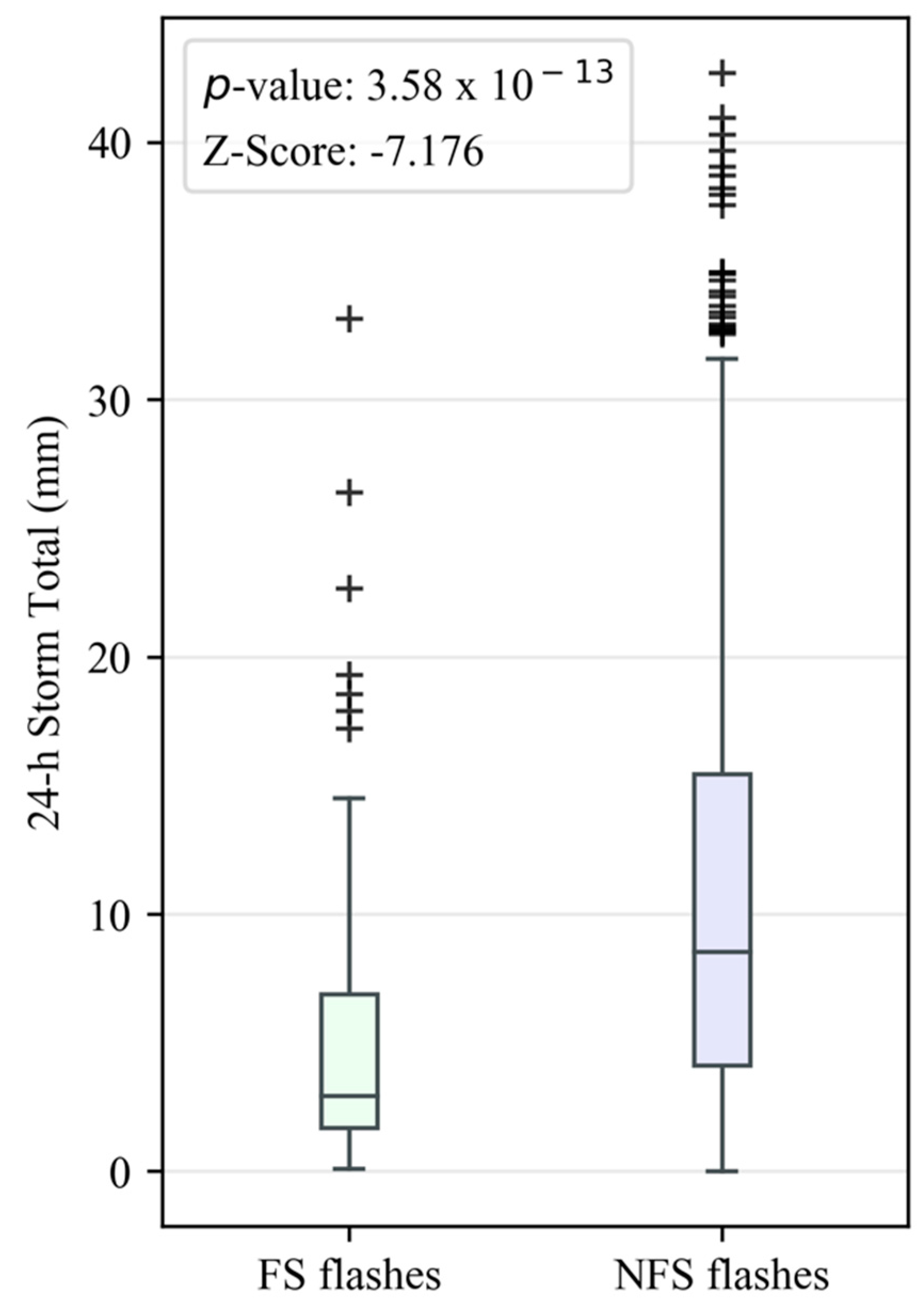
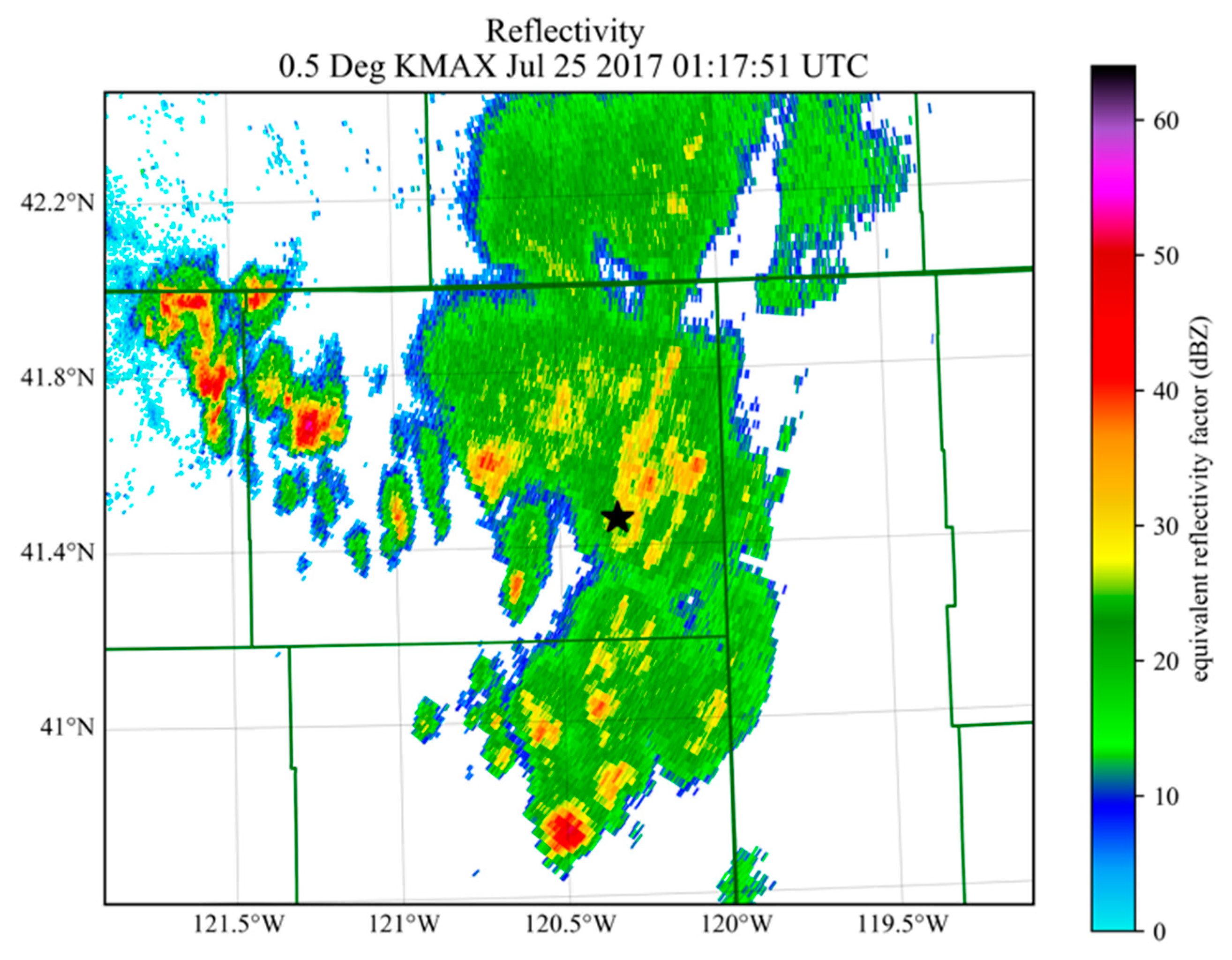
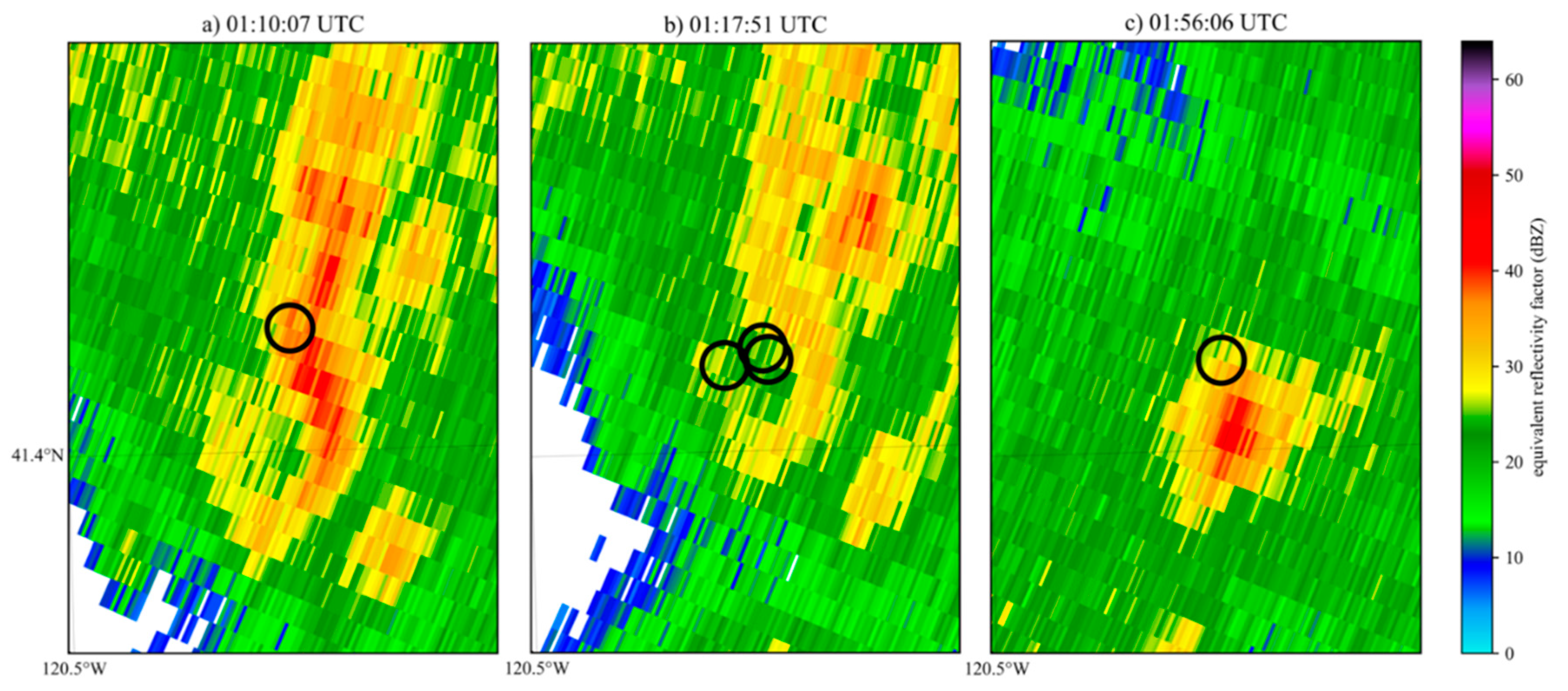
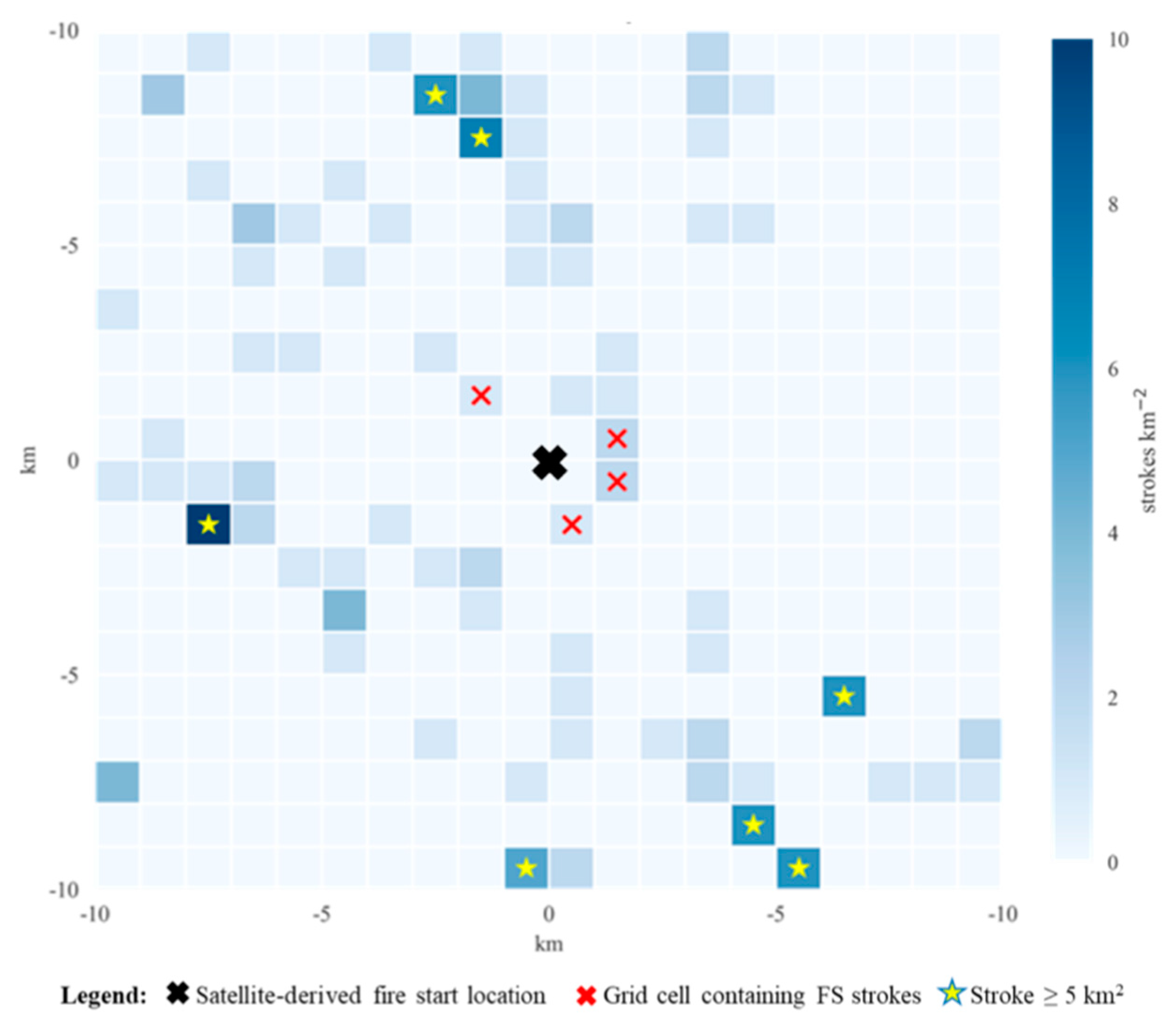


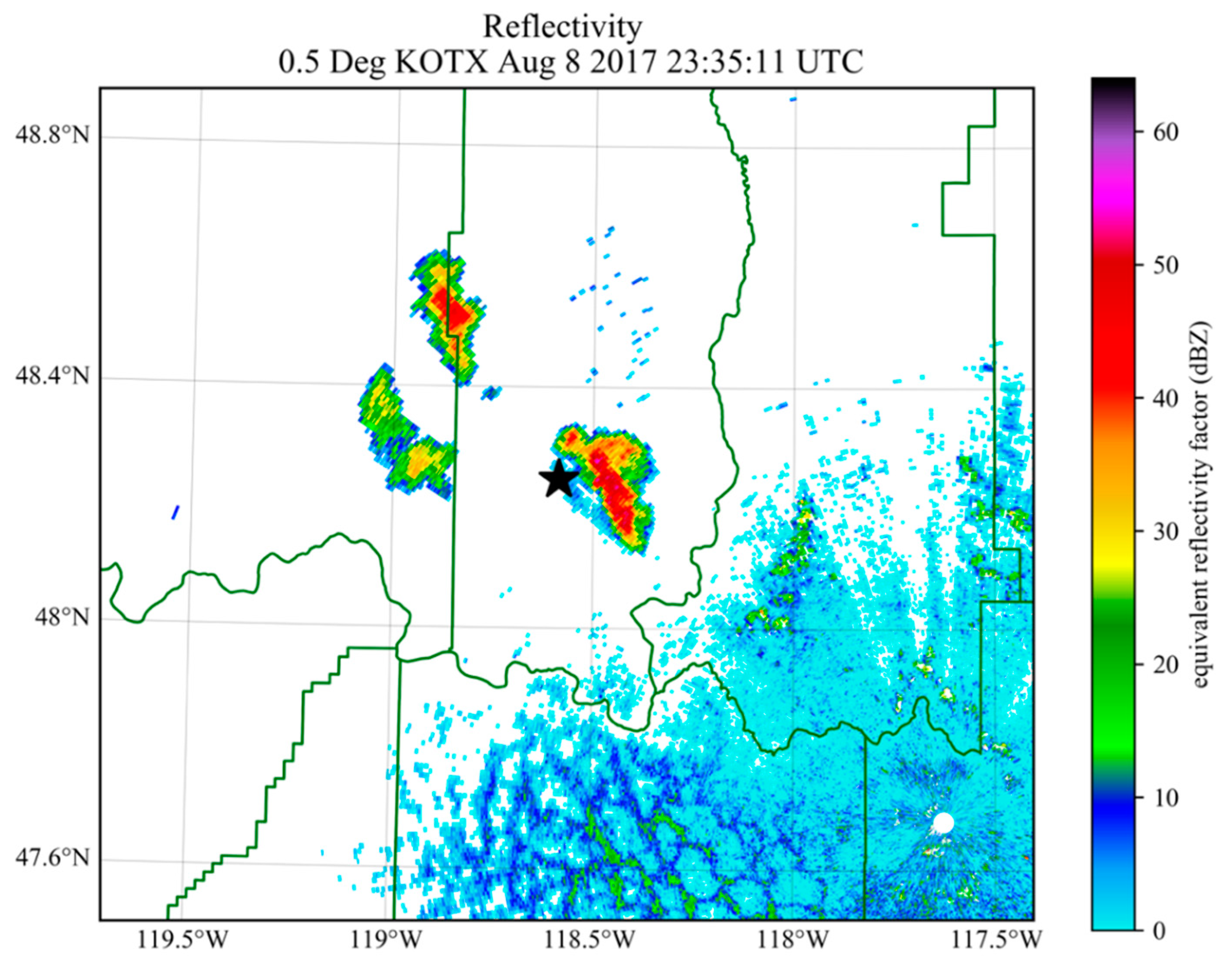
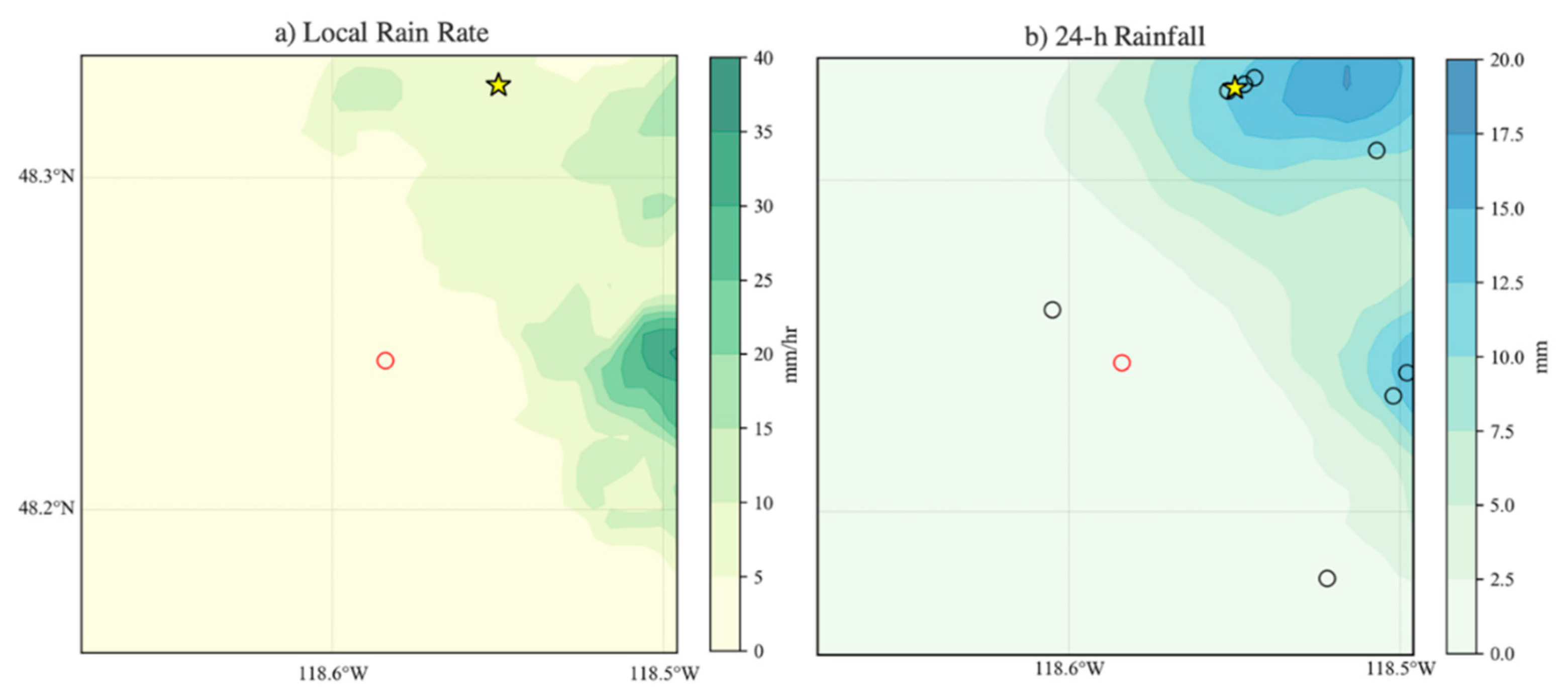
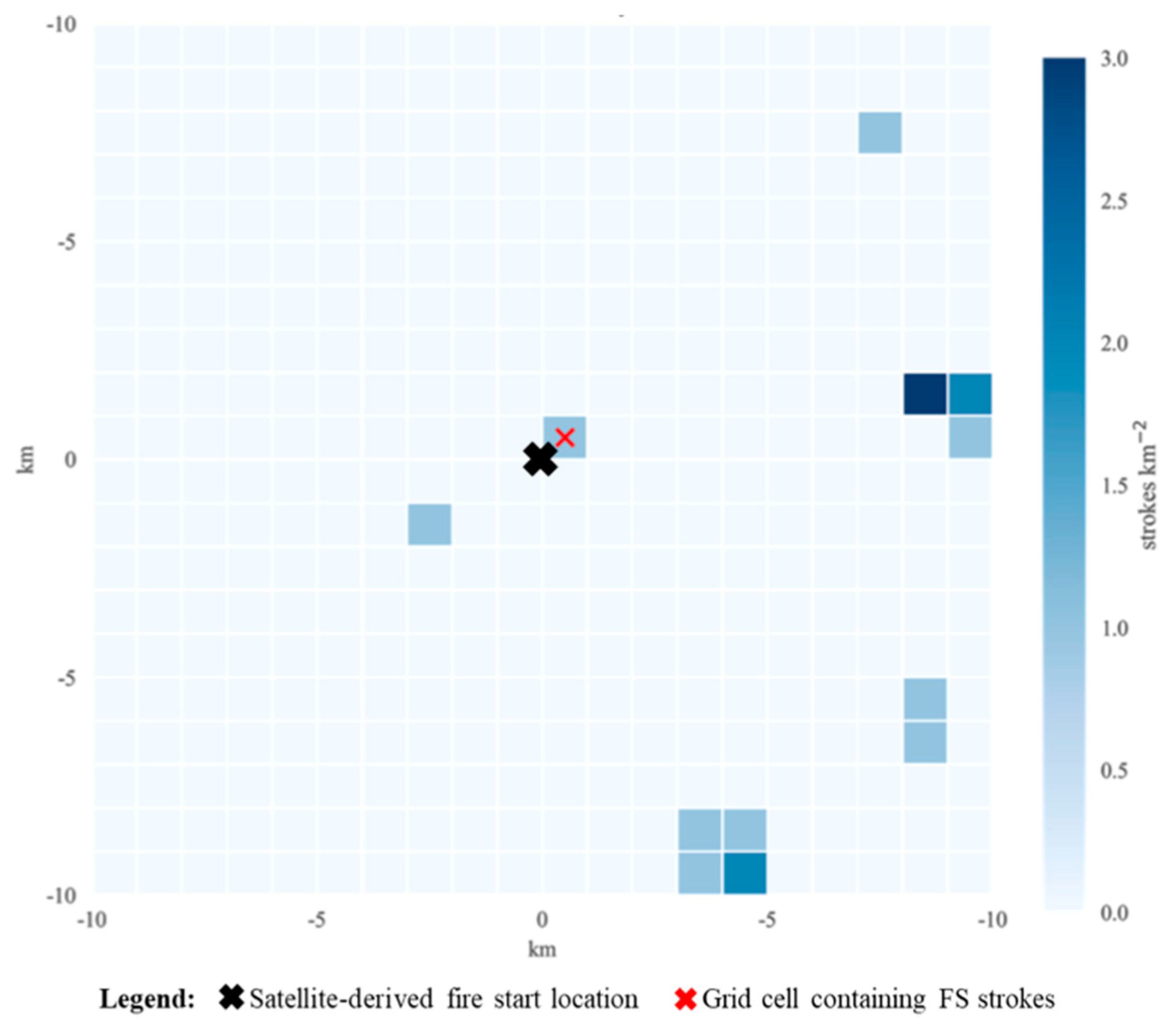
| Flash Type | No. of CG Flashes | Percentage | No. of Single Stroke Flashes | Mean Multiplicity | Median Ip (kA) |
|---|---|---|---|---|---|
| −CG FS | 126 | 88.7 | 59 | 3.0 | −21.1 |
| +CG FS | 16 | 11.3 | 13 | 1.2 | 30.0 |
| −CG NFS | 923 | 89.8 | 436 | 2.8 | −16.8 |
| +CG NFS | 105 | 10.2 | 94 | 1.2 | 21.5 |
| All −CG | 1049 | 89.7 | 494 | 2.8 | −17.3 |
| All +CG | 121 | 10.3 | 107 | 1.2 | 23.1 |
| Distance A (km) | Distance B (km) | Distance C (km) | |
|---|---|---|---|
| Minimum distance | 0.00 | 0.70 | 0.97 |
| 25th percentile | 2.85 | 4.66 | 4.66 |
| Median | 5.28 | 7.40 | 10.17 |
| Mean | 5.22 | 7.53 | 9.83 |
| 75th percentile | 7.66 | 10.35 | 13.00 |
| Maximum distance | 12.34 | 16.88 | 16.84 |
| Standard deviation | 3.23 | 3.64 | 4.12 |
| Time (UTC) | Lat | Lon | Multiplicity | Ip (kA) | Rain Rate (mm h−1) | 24−h Rainfall (mm) |
|---|---|---|---|---|---|---|
| 20:39:40 | 32.018 | −109.943 | 2 | −12.5 | 12.3 | 27.225 |
| 20:40:41 | 32.017 | −109.946 | 3 | −24.3 | 7.7 | 31.6 |
| 20:41:35 | 32.019 | −109.945 | 4 | −37.2 | 5 | 31.6 |
| 20:42:14 | 32.018 | −109.959 | 4 | −20.9 | 0.95 | 18.225 |
| 20:42:49 | 32.040 | −109.950 | 1 | −2 | 0.075 | 34.65 |
| 20:43:26 | 32.024 | −109.944 | 2 | −16.3 | 130.475 | 27.225 |
| 20:50:45 | 32.050 | −109.964 | 4 | −42 | 51.05 | 22.3 |
| 21:07:15 | 31.989 | −109.989 | 1 | −26.5 | 0.1 | 0 |
| 21:09:29 | 31.989 | −109.992 | 8 | −18.9 | 0.1 | 0 |
| 21:12:30 | 32.021 | −109.947 | 3 | −22.4 | 98.8 | 28.4 |
| 21:15:05 | 31.995 | −110.008 | 1 | −20.7 | 0 | 0.1 |
| 21:16:25 | 32.044 | −109.945 | 5 | −18.3 | 147.4 | 42.7 |
© 2020 by the authors. Licensee MDPI, Basel, Switzerland. This article is an open access article distributed under the terms and conditions of the Creative Commons Attribution (CC BY) license (http://creativecommons.org/licenses/by/4.0/).
Share and Cite
MacNamara, B.R.; Schultz, C.J.; Fuelberg, H.E. Flash Characteristics and Precipitation Metrics of Western U.S. Lightning-Initiated Wildfires from 2017. Fire 2020, 3, 5. https://doi.org/10.3390/fire3010005
MacNamara BR, Schultz CJ, Fuelberg HE. Flash Characteristics and Precipitation Metrics of Western U.S. Lightning-Initiated Wildfires from 2017. Fire. 2020; 3(1):5. https://doi.org/10.3390/fire3010005
Chicago/Turabian StyleMacNamara, Brittany R., Christopher J. Schultz, and Henry E. Fuelberg. 2020. "Flash Characteristics and Precipitation Metrics of Western U.S. Lightning-Initiated Wildfires from 2017" Fire 3, no. 1: 5. https://doi.org/10.3390/fire3010005
APA StyleMacNamara, B. R., Schultz, C. J., & Fuelberg, H. E. (2020). Flash Characteristics and Precipitation Metrics of Western U.S. Lightning-Initiated Wildfires from 2017. Fire, 3(1), 5. https://doi.org/10.3390/fire3010005




